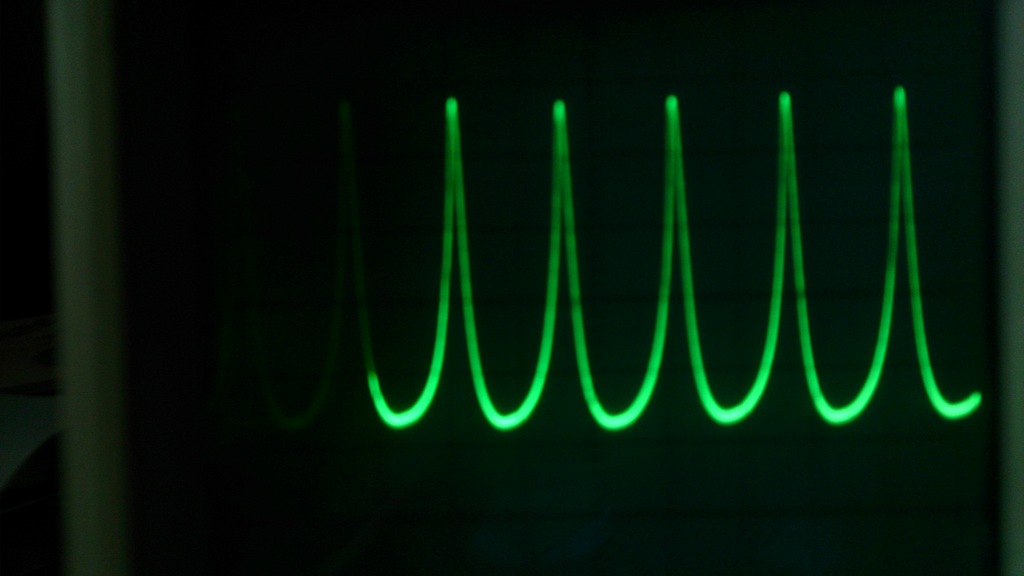New Oscilloscope and Phaser Problem
|
Double reason for posting, firstly I managed to pick up an analogue oscilloscope off ebay for £19.99. It an LG os5100, dual trace.and 100mhz bandwidth so should cover all I need and all is working well. Takes up a lot of desk space but looks so good.
Anyway my other reason for posting is that I have been using the oscilloscope to debug a problem with the liquid mercury phaser I built some time ago. The problem I have is that the sweep is very uneven when in sine lfo mode, I used the oscilloscope to measure the voltage across one of the vactrol leds (home made), this shows exactly what I'm hearing.  I have played around with the biasing and this is the best I can get it, any ideas? For interest I also took a couple of videos of the phaser in action on the oscilloscope showing dual trace and XY Mode these also show the problem (and look good) :) http://youtu.be/JkNGB99lKCA http://youtu.be/zfZ-XrUkiWQ |
|
OK, looked at the phaser again tonight since I realised that I should be seeing PWM output feeding the led and realised that when I thought I was probing the led I was actually probing one of the ldrs. I have now checked the led and can see a nicely modulated PWM signal that shows a nice sine modulation. But my problem still remains and it appears that the response of my homemade vactrols is the problem - I used green LEDs and gl55 series ldrs - don't really want to trial any error these since there are 3 dual vactrols in this, anybody have any suggestions?
Thanks for reading |
Re: New Oscilloscope and Phaser Problem
|
Try searching for linear response/recovery etc on LDR's. Might throw up some specific models.
Only thing I can really recommend is to either breadboard the LFO and scope different LDR's and LEDs (i know....sorry) or modify the LFO with some smoothing to gradually fade the LED up and down. I don't think there's an easy answer for this sorry. |
|
Thanks for your answer, the LFO uses the taplfo pic from electric druid, in theory I could adapt their code to change the waveform but that is beyond my capabilities as it is written in assembler. I did originally think it was down to response speed but it happens the same at low rates as it does at high ones, it does improve at lower modulation depths though. Since it is the dark end of the modulation that causes the problem I imagine that keeping the led on slightly might help - I will think about that, might reduce the depth too much though...
|
Re: New Oscilloscope and Phaser Problem
|
Ah. Sorry I didn't notice you said PWM. But you brought up a good point. I once had a build where my LDR's went too high dark. I didn't have any others to try so I paralleled them with a resistor.
Not sure how this may affect your particular build but it would at least be a quick test |
|
Thought about paralleling them up but then realised that the layout already has 220k resistors in parallel with each ldr. I will have a play with different combinations on breadboard and see what I can see.I have a lovetone doppelganger almost finished so I won't be shouldn't be short of phasers anyway.
|
|
Ok, I seem to have fixed the problem, at least it sounds good to my ears although possible the sweep range is rather small now but definitely improved the modulation. What I did was having measured the resistance of the ldr at various led currents I realised that although the response is generally it very linear it is exceptionally bad at the dark end, going from 5k at 1mA to 2m + at zero current, so needed to prevent the led going fully off. Since the PWM always swings to fully off at max depth I bypassed the switching transistors {there are 3 one for each pair of stages) with a 47k resistor which allows a continuous current to flow through the LEDs to prevent them going fully dark, this has removed the nasty spike in the sweep.
What this has made me realise is that these cheap ldrs are really not ideal for the job being more aimed towards on/off applications rather than applications needing a linear response. Incidentally noticed that Maplins in the UK have vactrols at under £3 each at the moment, sadly sold out local to me or I would have stocked up... |
«
Return to Open Chat
|
1 view|%1 views
| Free forum by Nabble | Edit this page |

